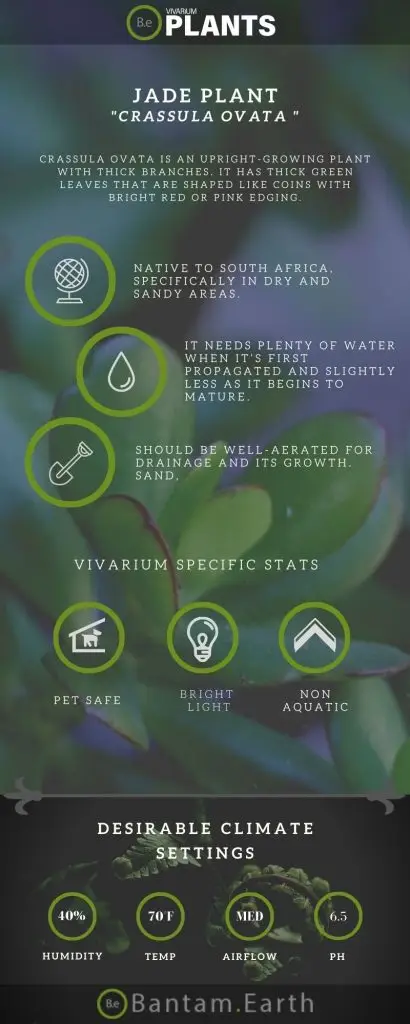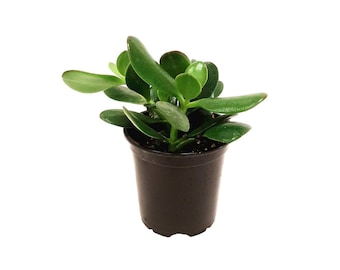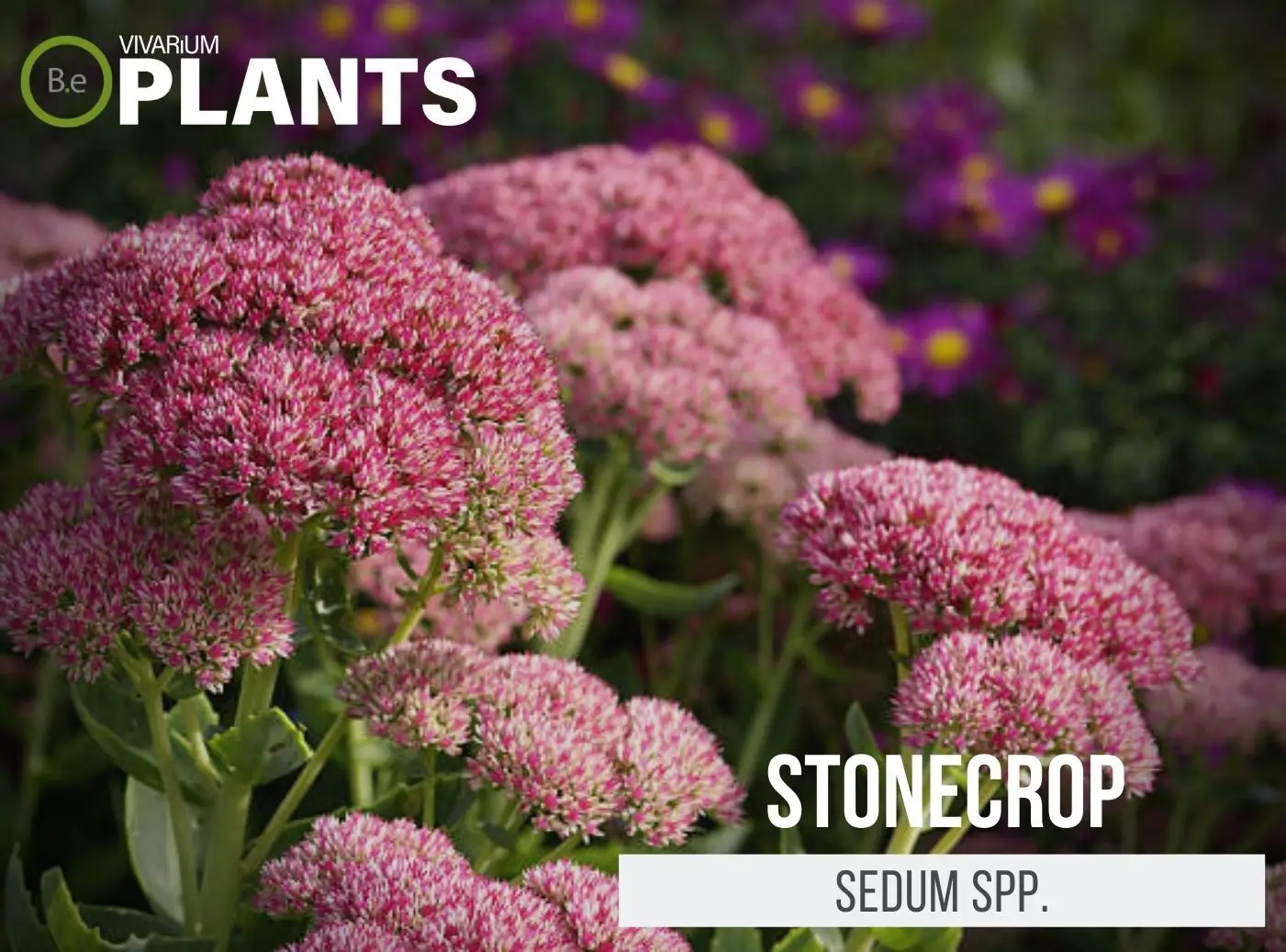Jade Plant is an ideal succulent for adding texture and color to your vivarium.
Not only is it beautiful, but it‘s also easy to maintain.
With minimal care requirements, Jade Plant is an excellent choice for beginners in terrarium gardening.
In this article, we‘ll explore the characteristics and care requirements of Crassula ovata, and discuss how to successfully incorporate it into your terrarium.
| Quick Stats: | |
|---|---|
| Scientific Name | Crassula ovata |
| Common Name | Jade plant, Money plant, Friendship plant, Lucky plant |
| Family Name | Crassulaceae |
| Habitat | Dry and sandy areas in South Africa |
| Temperature | 65°F to 75°F |
| Height | Up to 4 feet |
| pH | 6.0 to 7.5 |
| Lighting | Bright, indirect |
What is a Jade Plant?
Crassula ovata is a stemless succulent, commonly referred to as a jade plant.
It originates from South Africa, more specifically in dry and sandy areas.
It’s a perennial evergreen plant and happens to be the most common variety of succulents in its family.


Jade Plant Facts
Jade is known for its unique properties, being associated with friendship and luck, specifically in the Far East.
That said, it may have been spread by commercial traders over time, creating various myths and meanings through its travels.
The attractive coloration of its leaves pairs well with many types of vivarium setups and is a popular choice for many kinds of keepers.
Description
Crassula ovata is an upright-growing plant with thick branches.
It has thick green leaves that are shaped like coins with bright red or pink edging.
Its leaves are somewhat fleshy, giving them a rubbery feel.
While the leaves may appear small, the jade plant’s height can reach up to 4 feet.
Habitat
Crassula ovata is native to South Africa, specifically in dry and sandy areas.
It’s also quite adaptable and can survive in temperate climates and even colder temperatures.
Though for the best natural conditions, it should be kept away from hard frost.
pH Preference
This succulent prefers to be on the slightly acidic side of potential hydrogen.
It prefers pH levels in the range of 6.0 to 7.5, but it also can tolerate neutral levels.
Vivarium Type
The jade plant is quite an easy-going species.
With that in mind, it will not be too complicated when it comes to choosing the type of enclosure it is grown in.
It is best to try and replicate the plant’s natural habitat as much as possible.
Doing so will make it easier to provide this succulent plant with its basic needs.
The proper setup and theme of the enclosure will make a big difference to the overall look and health of the succulent.
Here are recommended vivariums it will do well in:
-
- Terrariums – Fully terrain-based enclosures with little to no aquatic features.
Vivarium Placement
The jade plant is an ideal choice for vivariums as it grows upwards, forming an attractive thicket of foliage.
Being able to grow in a variety of desert, grassland, and forest terrariums, the succulent can be placed in the background or the sides of an enclosure, helping to cover up the tank’s hardscape.
Substrate
The substrate for jade should be well-aerated for drainage and growth.
Sand, small gravel, and other loose textures won’t be ideal for this plant as its thick branches won’t be able to grab onto the substrate.
It should be planted in a firm, well-draining terrarium soil.
Lighting
The money plant can thrive in most light conditions, though it prefers indirect and bright terrarium light.
Avoid direct sunlight which will burn and dry out the leaves.
Buy Jade Plant
When it comes to buying a jade plant, there are a few things to keep in mind.
Making sure the plant is healthy when purchased is essential for its success in a vivarium.
Vegetation that is already in poor conditions will have a very hard time adjusting to new environments.
Click the image below to find out more about the current price and other relative info about this plant.
Jade Plant Care and Propagation
The jade plant is a slow-growing succulent, which requires little to no maintenance.
The best type of propagation is through stem cuttings, similar to propagation within other species of succulents, you can use a sharp, sterilized cutter to cut off a few inches from the mature branches.
Once you’ve done so, place them in mineral-rich potting soil for maximum growth.
How to Grow
The care for the jade plant is more involved at the start when first propagated, as not only does it require plenty of sunlight, but also plenty of water and nutrients for the first few weeks of growth when propagated.
After the plant is established, water it every two weeks and feed it a diluted nutrient-rich cactus fertilizer.
Watering
Watering is the key to the jade plant’s survival, as it needs plenty of water when it’s first propagated and slightly less as it begins to mature.
During the hot months, the jade plant should be watered twice a month, while during the colder months, it will need to be watered only once a month.
Do not allow it to dry out for long periods of time and make sure that no water is puddling at its base.
Plants Similar to Jade Plant
Adding diversity to an enclosure is key to an aesthetically pleasing setup.
Try mixing up the look of your vivarium with different flora that can easily co-exist in the same types of environment.
Furthermore, if for some reason you find the jade plant is hard to acquire or would like to consider something similar to this plant…
Here are other succulents you might find will do well with or in the place of Crassula ovata:
Conclusion
The jade plant is a stunning evergreen succulent that can be used to liven up any vivarium.
It is a slow-growing, low-maintenance, and worry-free terrarium plant, with the right kind of care and conditions, it can thrive and bring an eye-catching green and red/pink color back to any terrarium.
Frequently Asked Questions
Yes, jade plants need a lot of light in order to thrive. They should be placed in a spot that receives at least 6 hours of direct light each day. During the winter, they can tolerate a bit less light, but should still receive at least 4 hours of direct light per day.
A jade plant should be placed in a bright, sunny spot with indirect light. Make sure to rotate the plant periodically to ensure even growth. Allow the soil to dry completely between waterings and keep temperatures between 65–75°F (18–24°C).
When placing a jade plant in a terrarium, it is best to place it near the center of the terrarium, but not too close to the sides or top. It should be placed in an area that gets plenty of bright light and near a heat source. Make sure to provide adequate drainage and air circulation. Additionally, it is also important to provide well-draining soil.
Jade plants typically require watering once every 2–3 weeks. Make sure the soil is completely dry before the next watering.
No, jade plants do not need big pots. They prefer small, shallow pots that allow the roots to spread out. When re–potting, choose a pot that is only slightly larger than the current one.
The most likely cause of jade plant leaves falling off is due to overwatering. Jade plants prefer to have their soil dry out between waterings, so if the soil is consistently wet, the leaves may begin to fall off. Other possible causes include nutrient deficiencies, pests, or extreme temperatures. To prevent further leaf loss, make sure to water your jade plant only when the soil is dry, and provide it with adequate nutrients and a stable temperature.
To keep a jade plant bushy, it is important to prune it regularly. Prune the plant back when it has grown too large or become leggy, taking care to make clean cuts just above a leaf node. This will encourage the growth of new shoots and branches, making your jade plant fuller and bushier. Additionally, provide your jade plant with plenty of sunlight and water it when the soil is dry.




